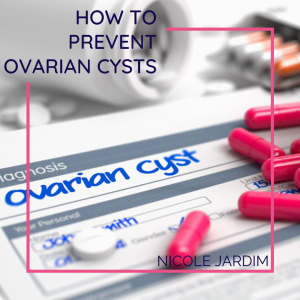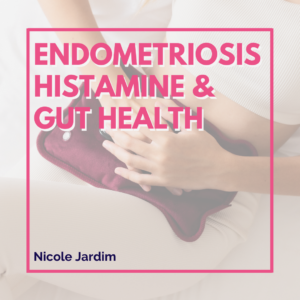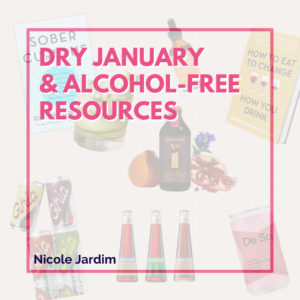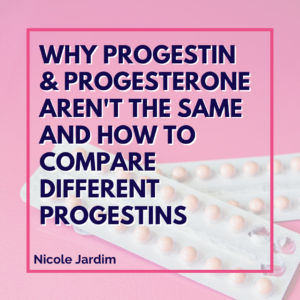Did you know that many women have ovarian cysts that occur each and every month? And that in most cases they are actually just the follicles your eggs are housed in?
They grow and shrink, often times without anyone’s knowledge. Usually just as a part of the normal ovulation cycle, follicles on your ovaries become enlarged, then they fade away, and you’re none the wiser.
But sometimes, these cysts can grow large. They don’t simply shrink and disappear the way they should. And they can rupture and even cause damage to your ovary.
If you’re experiencing pain mid-cycle, it could possibly be a sign of an ovarian cyst that’s getting ready to cause you issues, and it’s something I’d urge you to get checked out by a doctor right away.
Ideally, though, we can prevent these cysts from becoming problematic in the first place.
Because they’re ultimately caused by excess estrogen, we have many tools at our disposal for reducing the likelihood that an ovarian cyst will grow and rupture.
What Are Ovarian Cysts?
Quick refresher: each month (during your childbearing years), an ovary will wrap up an egg in a follicle. Then the follicle bursts and the egg gets released and you either get pregnant or get your period. The follicle then forms the corpus luteum (a temporary mini endocrine gland that produces progesterone). Soo cool, right?
However, if the follicle never releases the egg, it can grow larger and ultimately result in a follicular cyst.
Or, if the follicle bursts but then malfunctions, it can fill up with fluid and becomes a corpus luteum cyst.
These two types of cysts together are known as functional or simple cysts.
There are a few other, less common types of cysts, known as complex cysts:
- Endometriomas — these occur in women with endometriosis about 17-45% of the time. They occur when the uterine lining grows outside of the uterus and invades the ovaries.
- Cystadenomas — these types of cysts contain ovarian tissue coupled with mucus and fluids
- Dermoid — these rare cysts can occur in the ovaries, and also in the back or skull. They are comprised of tissue structures for things like teeth or hair.
While all of these cysts might sound a little scary, they are mostly benign, especially when they show up during pre-menopausal years.
What Are The Symptoms of Ovarian Cysts?
For the purpose of this article, we’ll talk about the simple, functional cysts (follicular cysts and corpus luteum cysts) since they occur as a direct result of the menstrual cycle.
The symptoms of these cysts are often non-existent. Like I said before, they usually grow, shrink, and disappear without you having any idea that they were even there.
However, when they become problematic, you may notice:
- Pelvic pain (especially ovulatory pain)
- Abdominal bloating (particularly around ovulation)
- Irregular cycles
- Lack of ovulation
- Fertility struggles
- Spotting or bleeding mid-cycle
- Painful urination (if the cyst is pressing on the bladder)
- Pain with bowel movements (if the cyst is putting pressure on the bowel)
- Nausea and/or vomiting
What Are The Treatment Options For Ovarian Cysts?
Ultimately, we can prevent these cysts from happening in the first place.
But, if you’ve already been told you have ovarian cysts, and you’re concerned about your options, here’s where treatment plans usually land:
- Your doctor may advise to watch and wait. After all, these things have a way of resolving themselves on their own.
- Physicians will likely try to prescribe hormonal contraceptives to help stop ovulation. If you don’t ovulate, in most cases you won’t produce any more cysts…this won’t affect the size of any existing cysts, though.
- If your cysts are severe or look suspicious, your doc may recommend surgery. Sometimes, this can be accomplished without removing the ovary, but other times, it may be necessary to remove the ovary along with the cyst. If you’re post-menopausal, it’s much more likely surgery will be offered as an option.
The problem with all of these options is they don’t address the actual reason you have cysts in the first place. Usually, I experience great success in treating existing ovarian cysts and preventing new ones by addressing one of the main root causes of the issue: too much estrogen.
This wonderful hormone does so many great things — like give you full breasts, great skin, strong bones and a healthy sex drive (va va voom!). But when it’s out of balance, it’s anything but fun.
Especially in today’s world where we are inundated with environmental toxins that mimic our natural estrogen, and our diets don’t exactly encourage healthy estrogen detoxification. This causes estrogen levels to rise, throwing off the estrogen/progesterone balance, causing all sorts of menstrual cycle drama — ovarian cysts being one of them.
Easy Ways To Increase Progesterone and Lower Estrogen
In order to get our estrogen levels to optimal levels (think cyst-free ovaries), we need to support its processing in the liver, and we need to expel it through our digestive system.
We also need to get progesterone levels up.
In my practice, I help women do this every single day, often with miraculous results.
Here are a few of my favorite tips to encourage happy hormones, optimal ovulation, and ultimately, fewer reproductive issues like ovarian cysts.
1. Eat Organic
Commercial pesticides and herbicides are full of endocrine disrupting chemicals. Basically, this means that when we’re eating produce that’s been heavily sprayed or protein that’s eaten food that’s been treated with pesticide, we’re ingesting chemicals that mess with our hormones. Furthermore, animal proteins can be treated with antibiotics and injected with hormones to make them grow faster. Eeeks! Try to stick to organic, locally sourced, grass fed, pasture raised options as much as possible to avoid the side effects that come from ingesting these harmful chemicals.
2. Lots Of Vegetables
Veggies are clear winners when it comes to promoting health, and hormone health is no exception. Cruciferous vegetables, like cabbage, broccoli, and brussels sprouts help the liver to process estrogen properly, ultimately reducing the excess levels of it that cause issues like ovarian cysts. Green, leafy vegetables like spinach, kale, and arugula, beet greens, and dandelion greens are like eating the rainforest – their nutrients help remove potentially harmful toxins in your blood, support your immune system and reduce inflammation.
3. Eat More Fat
Fat is crucial for creating hormonal harmony. Fats are actually structural components of our hormones. We have to eat cholesterol in order to make all those juicy sex hormones. Hopefully by now, all of the “fat is terrible for you” dogma from the 80’s and 90’s has been debunked. But just in case, I’m sayin’ it again now: eat fat. Your hormone levels and ovaries will thank you for it. Foods like coconut oil, wild-caught Alaskan salmon, avocados, nuts and seeds are all things you should have on your plate every day.
4. Whole Grains
I know, I know. Grains have a bad rap, but I’m generally not a big fan of cutting entire food groups out of our diets to support our hormones. Whole grains are great sources of fiber, and fiber helps you to get excess estrogen out of your body. I prefer gluten-free whole grains like quinoa and brown rice. Don’t be fooled by processed and packaged stuff like cereal and bread that claims to be whole grain. It’s not.
5. Increase B Vitamins
B vitamins are crucial for getting your hormones working for you, and I recommend that every woman take a high-quality B complex supplement (especially if you’re stressed – and who isn’t these days). B vitamins heavily influence the adrenal glands, increase progesterone levels and decrease estrogen, and they have been shown to relieve symptoms of PMS, especially when combined with magnesium or calcium. When we decrease estrogen, we’re shrinking ovarian cysts by cutting off their food supply.
6. Get in your Magnesium
Magnesium is an essential mineral that the majority of Americans aren’t getting enough of. Boo! It’s involved in over 300 enzymatic processes and is in every cell type in the body. Having enough magnesium means less PMS (hallelujah!) and it helps regulate the hypothalamic-pituitary-adrenal (HPA) axis – the part of your body responsible for how you respond to stress. In other words, low levels of it have been linked to high anxiety, and supplementation linked to lower levels of anxiety. It’s super important for the thyroid and it helps sleep. Bottom line — get you some magnesium in your life. It will only serve to help manage ovarian cysts.
7. Try SGS and DIM
Diindolylmethane (DIM) and Sulforaphane Glucosinolate (SGS) basically provide super concentrated benefits of cruciferous vegetables, without having to eat 12 cups of broccoli.
They help to support phase one and two of liver detoxification (estrogen is processed in two phases in the liver). DIM supports phase one of liver detoxification (breaking down hormones and neutralizing toxins). SGS has similar effects to DIM, but it supports phase two of liver detoxification (further processing hormones and toxins so they can be removed from the body).
DIM also shows promise for treatment of breast and uterine cancer for its potent effects on estrogen levels. Lowered estrogen = lowered chance of ovarian cysts. See my post on SGS and DIM for recommended dosages.
8. Figure Out How to Manage Your Stress
OK, I know this is easier said than done, but stress is a killer. I mean, burnout is now a legit thing, not some catch phrase we use to describe how we’re feeling at the end of a long week!
The effects of stress are a common culprit behind hormone imbalances, and when we’re stressed for long periods of time, it’s so much harder to get things back in line. Remember that stress increases cortisol, the stress hormone. It’s a vicious cycle that’s difficult to get out of, so you have to be really intentional about avoiding stressors that are avoidable and mitigating the effects of stressors that aren’t avoidable.
Try to start your day off on the right track. Put your phone in the living room or somewhere outside the bedroom so you’re not immediately grabbing it and checking emails or social as soon as you open your eyes. Make time to relax, play, and hang out with your girls. Your hormone levels will respond in kind.
Interested In Learning More?
I’d love to share more estrogen reducing, progesterone increasing goodness with you, girl!
If you join my mailing list, I’ll send you regular updates when I post new articles so you can continue to educate yourself on exactly how these hormones work and how they affect your body and health.
It’s my mission for every woman to feel empowered to take her health into her own hands and feel informed to make her own decisions about her period.
I’d love to help you do exactly that.
Sources
“Endocrine Disruptors Research – NIEHS – NIH.”
https://www.niehs.nih.gov/research/programs/endocrine/index.cfm
“Altered estrogen metabolism and excretion in … – NCBI – NIH.” https://www.ncbi.nlm.nih.gov/pubmed/1656396.
“Dietary fat intake and reproductive hormone … – NCBI – NIH.” 3 Feb. 2016, https://www.ncbi.nlm.nih.gov/pmc/articles/PMC4763493/.
“Effect of daily fiber intake on reproductive function: the … – NCBI.” 19 Aug. 2009, https://www.ncbi.nlm.nih.gov/pmc/articles/PMC2744625/.
“Nutritional factors in the etiology of the premenstrual … – NCBI.” https://www.ncbi.nlm.nih.gov/pubmed/6684167.
“Effect of Combined Use of Calcium and Vitamin B6 on … – NCBI.” https://www.ncbi.nlm.nih.gov/pmc/articles/PMC4794546/.
“Evaluating the effect of magnesium and magnesium … – NCBI.” https://www.ncbi.nlm.nih.gov/pubmed/22069417.
“Magnesium — Health Professional Fact Sheet.” 11 Oct. 2019,
https://ods.od.nih.gov/factsheets/Magnesium-HealthProfessional/
“Severely low serum magnesium is associated with … – NCBI.” 2 Jul. 2018, https://www.ncbi.nlm.nih.gov/pmc/articles/PMC6028657/.
“The effect of magnesium supplementation on primary … – NCBI.” https://www.ncbi.nlm.nih.gov/pubmed/23853635.
“Magnesium in the gynecological practice: a literature … – NCBI.” 1 Feb. 2017,
https://www.ncbi.nlm.nih.gov/pubmed/28392498
“[Magnesium–a new therapeutic alternative in primary … – NCBI.” https://www.ncbi.nlm.nih.gov/pubmed/2675496.
“Magnesium supplementation alleviates premenstrual … – NCBI.” https://www.ncbi.nlm.nih.gov/pubmed/9861593.
“The Effects of Magnesium Supplementation on … – NCBI – NIH.” 26 Apr. 2017, https://www.ncbi.nlm.nih.gov/pmc/articles/PMC5452159/.
“Magnesium deficiency induces anxiety and HPA axis … – NCBI.” https://www.ncbi.nlm.nih.gov/pmc/articles/PMC3198864/.
“A randomized, placebo-controlled trial of … – NCBI – NIH.” 30 May. 2017, https://www.ncbi.nlm.nih.gov/pmc/articles/PMC5571834/.




1 thought on “How to Prevent Ovarian Cysts”
EVERYTHING is excess frickin’ estrogen! It’s crazy. It’s like you look up any sort of gynecological ailment and it’s “We don’t know why this happens, but it goes away after menopause. We’re pretty sure estrogen has something to do with it.” Naw… Ya think?
BTW, calcium d glucarate is also very good. I’m not sure of the stage of detox or whatever, but I know that it helps the liver process out estrogen metabolites. It works like Tamoxifem without the side effects. I take this and DIM, and the complex cyst I had on my right ovary went away like it was supposed to.